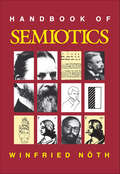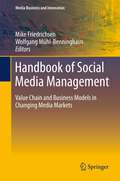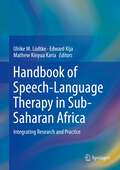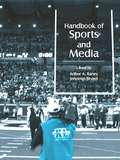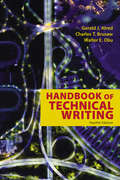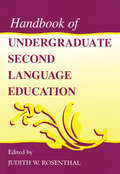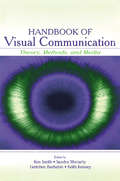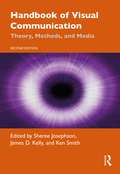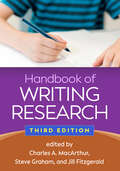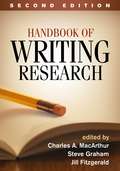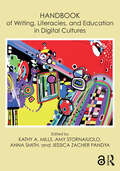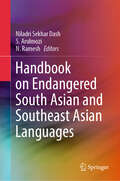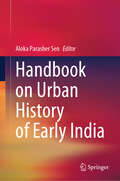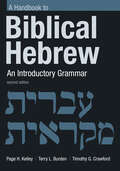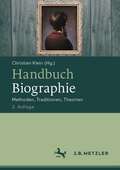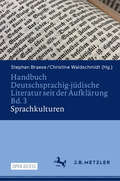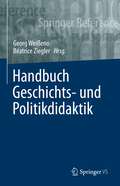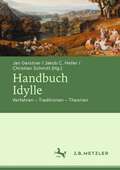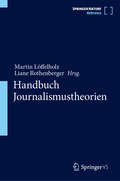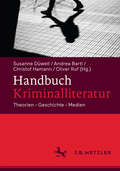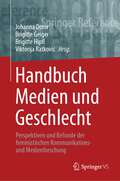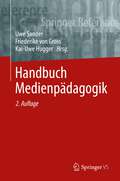- Table View
- List View
Handbook of Semiotics (Advances in Semiotic)
by Winfried Nöth"This is the most systematic discussion of semiotics yet published." —Choice"A bravura performance." —Thomas Sebeok"Nöth's handbook is an outstanding encyclopedia that provides first-rate information on many facets of sign-related studies, research results, and applications." —Social Sciences in General
Handbook of Social Media Management: Value Chain and Business Models in Changing Media Markets
by Mike Friedrichsen Wolfgang Mühl-BenninghausDigitization and Web 2.0 have brought about continuous change from traditional media management to new strategic, operative and normative management options. Social media management is on the agenda of every media company, and requires a new set of specialized expertise on digital products and communication. At the same time, social media has become a vibrant field of research for media economists and media management researchers. In this handbook, international experts present a comprehensive account of the latest developments in social media research and management, consistently linking classical media management with social media. The articles discuss new theoretical approaches as well as empirical findings and applications, yielding an interesting overview of interdisciplinary and international approaches. The book's main sections address forms and content of social media; impact and users; management with social media; and a new value chain with social media. The book will serve as a valuable reference work for researchers, students and professionals working in media and public relations.
Handbook of Speech-Language Therapy in Sub-Saharan Africa: Integrating Research and Practice
by Ulrike M. Lüdtke Edward Kija Mathew Kinyua KariaThis book synthesizes research on language development and communication disability in Sub-Saharan Africa and highlights best practices for providing speech and language therapy services to individuals with language, communication, and hearing disorders across the lifespan. The book brings together a wide range of international contributions from various disciplines, such as speech-language pathology, audiology, developmental psychology, language education, social work, neurology, neuropsychology, pediatrics, linguistics, pedagogy, and phonetics to provide perspectives on problems, challenges, ideas, concepts, and models to serve the people in Sub-Saharan Africa. Key areas of coverage include:Challenges for speech-language therapists in the health sector.Community awareness and the sustainable delivery of services.Culture-specific support of communication and language development in early childhood.Malnutrition, dysphagia, feeding difficulties, pediatric HIV, and related issues.Communication disability treatments, including assessment and intervention, augmentative and alternative communication (AAC), and issues specific to bilingualism and biliteracy.Inclusive education of children with communication disorders with case studies from Rwanda, Tanzania, Kenya, and South Africa. The Handbook of Speech-Language Therapy in Sub-Saharan Africa is an essential reference for researchers, professors, and graduate students as well as clinicians, therapists, and other professionals in developmental psychology, speech-language pathology and therapy, social work, neuropsychology, pediatrics, special education, community based rehabilitation, and all related disciplines.
Handbook of Sports and Media (Routledge Communication Series)
by Jennings Bryant Arthur A. RaneyThis distinctive Handbook covers the breadth of sports and media scholarship, one of the up-and-coming topics bridging media entertainment, sports management, and popular culture. Organized into historical, institutional, spectator, and critical studies perspectives, this volume brings together the work of many researchers into one quintessential volume, defining the full scope of the subject area. Editors Arthur Raney and Jennings Bryant have recruited contributors from around the world to identify and synthesize the research representing numerous facets of the sports-media relationship. As a unique collection on a very timely topic, the volume offers chapters examining the development of sports media; production, coverage, and economics of sports media; sports media audiences; sports promotion; and race and gender issues in sports and media. Unique in its orientation and breadth, the Handbook of Sports and Media is destined to play a major role in the future development of this fast-growing area of study. It is a must-have work for scholars, researchers, and graduate students working in media entertainment, media psychology, mass media/mass communication, sports marketing and management, popular communication, popular culture, and cultural studies.
Handbook of Technical Writing
by Gerald J. Alred Charles T. Brusaw Walter E. Oliu<P><P> This classic book remains the complete technical-writing reference for students and professionals alike. Alphabetically organized and easy-to-use, its nearly 400 entries provide guidance for writing all the most common types of professional documents and correspondence, including reports, proposals, manuals, memos, and white papers. Abundant real-world sample documents and visuals throughout the book demonstrate effective technical communication, reflecting current practices for formatting documents and using email. In addition, advice for organizing, researching, writing, and revising complements thorough treatment of grammar, usage, style, and punctuation to provide comprehensive help with writing skills. <P><P> This edition has been thoroughly revised to include updated advice for analyzing the context of different writing situations, using and integrating visuals, and dealing with ethical concerns in technical writing. Expanded coverage of the latest types of writing for the Web discusses FAQs and blogs as forms of collaborative writing and business promotion. New Digital Tips focus on using technology to assist with writing tasks, such as using wikis for collaborative documents. <P><P> Entries throughout the book have been revised, updated, consolidated, and streamlined to provide the most accurate and accessible information. Comprehensive yet concise, the Handbook of Technical Writing remains the quick reference faithful users have come to appreciate.
Handbook of Undergraduate Second Language Education
by Judith W. RosenthalThis volume offers the most comprehensive, up-to-date description of the wide array of second language programs currently available to undergraduate students in the United States and abroad. It brings together, for the first time, detailed descriptions of programs in foreign language, English as a second language (ESL), dual language (bilingual), American Sign Language, Native American, and heritage languages. Addressing both theory and practice, the volume presents the historical development, current practices, and future directions of each type of program, along with detailed case studies. For second language teachers, academic administrators, and teacher educators, this Handbook provides information that will be useful in making instructional and programmatic planning decisions.
Handbook of Visual Communication: Theory, Methods, and Media (Lea’s Communication Series)
by Sandra Moriarty Keith Kenney Kenneth L. Smith Gretchen BarbatsisThis Handbook of Visual Communication explores the key theoretical areas in visual communication, and presents the research methods utilized in exploring how people see and how visual communication occurs. With chapters contributed by many of the best-known and respected scholars in visual communication, this volume brings together significant and influential work in the visual communication discipline.The theory chapters included here define the twelve major theories in visual communication scholarship: aesthetics, perception, representation, visual rhetoric, cognition, semiotics, reception theory, narrative, media aesthetics, ethics, visual literacy, and cultural studies. Each of these theory chapters is followed by exemplar studies in the area, demonstrating the various methods used in visual communication research as well as the research approaches applicable for specific media types.The Handbook serves as an invaluable reference for visual communication theory as well as a useful resource book of research methods in the discipline. It defines the current state of theory and research in visual communication, and serves as a foundation for future scholarship and study. As such, it is required reading for scholars, researchers, and advanced students in visual communication, and it will be influential in other disciplines in which the visual component is key, including advertising, persuasion, and media studies. The volume will also be useful to practitioners seeking to understand the visual aspects of their media and the visual processes used by their audiences.
Handbook of Visual Communication: Theory, Methods, and Media (Routledge Communication Series)
by Ken Smith Sheree Josephson James D. KellyThis Handbook of Visual Communication explores the key theoretical areas and research methods of visual communication. With chapters contributed by many of the best-known and respected scholars in visual communication, this volume brings together significant and influential work in the discipline. The second edition of this already-classic text has been completely revised to reflect the metamorphosis of communication in the last fifteen years and the ubiquity of visual communication in our modern mediated lifestyle. Thirteen major theories of communication are defined by the top experts in their fields: perception, cognition, aesthetics, visual rhetoric, semiotics, cultural studies, ethnography, narrative, media aesthetics, digital media, intertextuality, ethics, and visual literacy. Each of these theory chapters is followed by an exemplar study or two in the area, demonstrating the various methods used in visual communication research as well as the research approaches applicable for specific media types. The Handbook serves as an invaluable reference for visual communication theory as well as a useful resource book of research methods in the discipline. It defines the current state of theory and research in visual communication and serves as a foundation for future scholarship and study. The Handbook of Visual Communication is a theoretical and methodological handbook for visual communication researchers and a compilation for much of the theoretical background necessary to understand visual communication. It is required reading for scholars, researchers, and advanced students in visual communication, and it will be influential in other disciplines such as advertising, persuasion, and media studies. The volume will also be essential to media practitioners seeking to understand the visual aspects of how audiences use media to contribute to more effective use of each specific medium.
Handbook of Writing Research
by Steve Graham Jill Fitzgerald Charles A. MacArthurSynthesizing the breadth of current research on the teaching and learning of writing, the third edition of this definitive handbook has more than 90% new content, reflecting the growth and dynamism of the field. Leading scholars--including many international voices--review major theories, developmental issues, and instructional approaches for students at all grade levels. Cognitive and sociocultural aspects of writing are explored in depth, as are assessment principles and methods. Issues in teaching students with disabilities, multilingual students, and culturally diverse students are addressed. The volume discusses innovative research methods and educational technologies and identifies key directions for future investigation. New to This Edition Chapters on executive functions in writing; disciplinary writing in math, science, and social studies; the role of vocabulary in writing; and formative assessment. Chapters on source-based writing, source evaluation, and writing development and instruction for African American students. Chapters on sociocultural aspects of writing--from critical literacies to agency and identity, social justice issues, and more--plus an emphasis on integrating cognitive and sociocultural perspectives throughout.
Handbook of Writing Research, Second Edition
by Steve Graham Charles A. Macarthur Jill FitzgeraldThe definitive reference in the field, this volume synthesizes current knowledge on writing development and instruction at all grade levels. Prominent scholars examine numerous facets of writing from sociocultural, cognitive, linguistic, neuroscience, and new literacy/technological perspectives. The volume reviews the evidence base for widely used instructional approaches, including those targeting particular components of writing. Issues in teaching specific populations--including students with disabilities and English learners--are addressed. Innovative research methods and analytic tools are clearly explained, and key directions for future investigation identified. New to This Edition *Chapters on genre instruction, evaluation and revision, argumentative writing, computer-based instruction, and professional development. *Chapters on new literacies, out-of-school writing, translation, and self-regulation. *Many new topics and authors, including more international perspectives. *Multiple chapters connect research findings to the Common Core writing standards. See also the editors' Best Practices in Writing Instruction, Second Edition, an accessible course text and practitioner's guide.
Handbook of Writing, Literacies, and Education in Digital Cultures
by Anna Smith Kathy A. Mills Jessica Zacher Pandya Amy StornaiuoloAt the forefront of current digital literacy studies in education, this handbook uniquely systematizes emerging interdisciplinary themes, new knowledge, and insightful theoretical contributions to the field. Written by well-known scholars from around the world, it closely attends to the digitalization of writing and literacies that is transforming daily life and education. The chapter topics—identified through academic conference networks, rigorous analysis, and database searches of trending themes—are organized thematically in five sections: Digital Futures Digital Diversity Digital Lives Digital Spaces Digital Ethics This is an essential guide to digital writing and literacies research, with transformational ideas for educational and professional practice. It will enable new and established researchers to position their studies within highly relevant directions in the field and to generate new themes of inquiry.
Handbook of the International Phonetic Association
by International Phonetic AssociationThis book is a comprehensive guide to the International Phonetic Alphabet, widely used for over a century to transcribe the sounds of languages. The Handbook is in three parts: Part I contains an introduction to phonetic description and exemplification of the use of phonetic symbols; Part II consists of twenty-nine "Illustrations" of the application of the International Phonetic Alphabet to a range of languages; and Part III covers speech pathology, computer codings, and the history of the IPA. This is an essential reference work for phoneticians and linguists more generally.
Handbook on Endangered South Asian and Southeast Asian Languages
by Niladri Sekhar Dash S. Arulmozi N. RameshThe handbook delves into the linguistic features of Southeast Asian and South Asian endangered languages, providing detailed descriptions and analyses. Each chapter covers a range of topics, including linguistic properties, extralinguistic aspects, and issues related to preserving and promoting endangered languages. The book also includes an ethnolinguistic profile for each language, discussing its official status, state of endangerment, demography, and usage. It discusses the methodological issues related to collecting and analyzing linguistic data. Furthermore, the book describes the unique linguistic features of each language, covering phonology, morphology, morphosyntax, and other linguistic aspects. By doing so, the book highlights how new linguistic features and findings can reflect on the community. Given the context of UNESCO's declaration of the 'International Decade of Indigenous Languages 2022-2032', this book offers valuable insights for students, researchers, policymakers, government agencies, educators, and linguists. It is an informative volume for scholars working on various endangered languages worldwide.
Handbook on Urban History of Early India
by Aloka Parasher SenThis handbook addresses issues around urban growth in early India. It provides theoretical and empirical insights from the perspective of the different regions of the subcontinent using various sources. The book chapters discuss how early urban forms evolved, transformed, and survived on the subcontinent, beginning with the third millennium BCE. This volume also looks at how urban space gradually emerged in borderland areas of the subcontinent and hill areas, which throw up relevant issues and questions of how we need to review elements of what we define as 'urban'. It includes chapters on both the early historic and early medieval periods. The book provides a comprehensive view of early India's urban history, insights into metallic money and cities, the origin of cities and waterways, geospatial and remote sensing techniques to reflect on the emergence of historic settlements, and so on. The contributors have presented the dialectical relationship between the city and the country in their chapters. The book covers themes such as the Indus Valley civilization, the rise of cities in the Ganges valley, the cultural setting of the multi-ethnic and multi-lingual Kushan cities, the dynamic of the growth of cities in the ancient Tamilakam, theories of urbanization, archaeological and epigraphic material reflecting on the first cities in different regions of the subcontinent, etc. It is an invaluable resource for students, researchers, and scholars in history, architecture, and archaeology, as well as scholars working on Indic studies.
Handbook to Biblical Hebrew: An Introductory Grammar
by Page H. Kelley Terry L. BurdenComprehensive in scope, Page Kelley's Biblical Hebrew: An Introductory Grammar is a carefully crafted introduction to the Hebrew language that offers easy-to-understand explanations, numerous biblical illustrations, and a wide range of imaginative, biblically based exercises. Thirty-one lessons present grammatical concepts with examples and numerous exercises judiciously selected from the biblical text. This accompanying handbook provides a complete answer key to the exercises in the grammar as well as practical guidance, footnotes, word lists, test suggestions, and other supplementary material.
Handbuch Biographie: Methoden, Traditionen, Theorien
by Christian KleinDas Handbuch liefert einen Überblick über die verschiedenen Formen und Felder biographischen Erzählens. Es informiert systematisch und disziplinenübergreifend über Funktionen, Typen, Geschichte und kulturelle Traditionen der Biographik. Daneben wird biographisches Arbeiten als wissenschaftliche Methode in den Geistes-, Sozial- und Kulturwissenschaften bzw. in der Medizin vorgestellt. Schließlich werden Kategorien zur Analyse biographischen Erzählens eröffnet und grundlegende Praxis-Fragen (zu Konzeption, Umsetzung, Publikation, juristischen Aspekten) beantwortet. - Die 2. Auflage bringt 8 neue Texte zur Transnationalität, zu Comics und Graphic Novel, zur Objektbiographie, zum »Biographischen Paradox«, zu Digital Humanities und den Queer Studies, zur Metabiographik und zu den Tendenzen und Debatten der Gegenwart. Alle Artikel sind aktualisiert.
Handbuch Deutschsprachig-jüdische Literatur seit der Aufklärung Bd. 3: Sprachkulturen (Handbuch Deutschsprachig-jüdische Literatur seit der Aufklärung. Neue Forschungszugänge in Paradigmen)
by Stephan Braese Christine WaldschmidtDas Handbuch bietet eine anhand von 6 Paradigmen entfaltete Darstellung deutschsprachig-jüdischer Literatur seit der Aufklärung. Ausgangspunkt ist die These, dass jüdisches Denken und deutschsprachig-jüdische Literatur nicht primär assimilatorisch an literarischen und wissenschaftlichen Entwicklungen im deutschsprachigen Raum partizipierten, sondern diese in dialogischer Weise und Impulse gebend maßgeblich mitkonstituiert haben. Der Band Sprachkulturen befasst sich mit den politischen und kulturellen Bedingungen, unter denen die deutsche Sprache in jüdischen Lebenswelten geteilt wurde und ihre Literatur sowie die Praxis jüdischer Mehrsprachigkeit prägte. Er analysiert exemplarisch diese Sprachkulturen im jeweiligen historischen Gegenüber zur Deutschsprachigkeit der Mehrheitsgesellschaft und als produktiven literarischen Ausdruck jüdischer Selbstbehauptung und jüdischen Selbstverständnisses.Dies ist ein Open-Access-Buch.
Handbuch Geschichts- und Politikdidaktik
by Georg Weißeno Béatrice ZieglerDieses Handbuch fasst die Diskussion zur Geschichts- und Politikdidaktik systematisch zusammen. Die Beiträge sind aus dem Blickwinkel der jeweiligen Didaktik als eigenständiger Wissenschaftsdisziplin verfasst, benennen die entsprechenden Kontroversen und zeigen die wichtigsten Forschungsentwicklungen auf. Die Zielgruppe des Handbuches sind Wissenschaftlerinnen und Wissenschaftler, die sich einen breiten und fundierten Überblick zu einer Thematik verschaffen wollen – von Studierenden bis zu Professorinnen und Professoren.
Handbuch Idylle: Verfahren – Traditionen – Theorien
by Christian Schmitt Jan Gerstner Jakob C. HellerDas Handbuch dokumentiert den Stand der Idyllenforschung und zeigt neue Wege auf, um die ‚Idylle‘ und das ‚Idyllische‘ literatur- und kulturwissenschaftlich zu erfassen. Damit erfüllt es das Desiderat eines zeitgenössischen Konzepts der Gattung, das auch idyllische Phänomene im weiteren Sinne umfasst. Beiträge aus unterschiedlichen Philologien sowie aus Musik-, Theater-, Medien- und Kunstwissenschaften ergänzen den germanistischen Schwerpunkt des Handbuchs. Sie legen die transnationalen und transmedialen Traditionslinien der Gattung von der Antike bis zur Gegenwart frei, erproben etablierte ebenso wie neue theoretische Ansätze und erläutern konstitutive Topoi. Das Handbuch begreift die Idylle als Effekt idyllisierender Verfahren und präsentiert sie so als in sich dynamische und widerspruchsvolle Form. Damit eröffnet es auch neue Wege, zeitgenössischen Transformationen des Idyllischen in Kultur und Politik analytisch zu begegnen.
Handbuch Journalismustheorien
by Martin Löffelholz Liane RothenbergerDie aktualisierte, neu strukturierte und um 19 Originalbeiträge ergänzte Neuauflage des Handbuchs Journalismustheorien liefert einen systematischen und detaillierten Überblick über die theoretischen Ansätze der Journalismusforschung. Zehn thematische Abschnitte ermöglichen schnelle Einstiege in die jeweiligen Theorienkomplexe und schaffen eine verständliche Orientierung über die Grundlagen, Entwicklungsstränge, Konzepte und Problemfelder der Journalismustheorien sowie darüber hinaus zu theoretischen Ansätzen zu Interrelationen des Journalismus mit Bereichen wie Kultur, Politik, Religion, Sport, Wirtschaft oder Wissenschaft. Für Studierende und Forschende der Journalistik, der Kommunikationswissenschaft und angrenzender Disziplinen bildet das Handbuch ein Standardwerk zum Verständnis des komplexen wissenschaftlichen Diskurses über die theoretischen Ansätze der Journalismusforschung.
Handbuch Kriminalliteratur: Theorien – Geschichte – Medien
by Christof Hamann Susanne Düwell Andrea Bartl Oliver RufDas Handbuch entfaltet erstmals einen systematischen, theoriegeleiteten und historisch fundierten Überblick zur Kriminalliteratur. Sowohl literaturwissenschaftliche Konzepte von der Gattungsreflexion bis zu Raumtheorien kommen darin zum Tragen als auch Theorien des Kriminalromans und poetologische Ansätze. Wesentliche Aspekte wie z.B. Paranoia, Geständnis oder Rätsel und zentrale Figuren des Genres werden in den Blick genommen. Einen weiteren Schwerpunkt bildet die Literaturgeschichte der deutschsprachigen Kriminalliteratur seit ihren Anfängen im 17. Jahrhundert. Das Handbuch schließt mit Beiträgen zum Krimi in Film, Fernsehen, Hörspiel, Comic und in den digitalen Medien.
Handbuch Medien und Geschlecht: Perspektiven und Befunde der feministischen Kommunikations- und Medienforschung
by Brigitte Hipfl Johanna Dorer Brigitte Geiger Viktorija RatkovićDer Band bietet einen systematischen Überblick über die Grundlagen, Theorien und empirischen Befunde der feministischen Kommunikations- und Medienwissenschaft. Die Beiträge behandeln die Entwicklungen und den aktuellen Stand der gesamten Breite der kommunikationswissenschaftlichen Geschlechterforschung: Informations- und Unterhaltungsangebote der Medien, Fernseh- und Filmgenres, Social Media, Journalismus, Werbung, Öffentlichkeitsarbeit, Medienpolitik, Medienpädagogik, Medienpsychologie und Medienethik aus Geschlechterperspektive werden ebenso systematisch dargestellt wie die Themen der Frauenbewegung, Gewalt, Körper- und Sexualitätsdiskurse in Medien.
Handbuch Medienpädagogik
by Uwe Sander Kai-Uwe Hugger Friederike Von GrossDas Handbuch Medienpädagogik liefert Studierenden, pädagogischen Praktikern und Wissenschaftlern einen fundierten und systematisch aufgebauten Überblick über Theorie, Forschung, Geschichte, gegenwärtige Diskussionspunkte und Handlungsfelder der noch verhältnismäßig jungen erziehungswissenschaftlichen Teildisziplin Medienpädagogik. Unterschiedliche Expertinnen und Experten behandeln Strömungen und Theorien der Medienpädagogik, Methoden und Richtungen der Medienforschung sowie den Zusammenhang von Medienentwicklung und Medienpädagogik. Weiterhin werden Aufgaben und Handlungsfelder sowie berufliche und professionelle Aspekte der Medienpädagogik diskutiert.
Handbuch Medienökonomie
by Jan Krone Tassilo PellegriniDas Handbuch hat den Anspruch, die Medienökonomie vor dem Hintergrund der voranschreitenden Digitalisierung von Kommunikation, Medienproduktion, Medienvertrieb sowie der Anpassung ordnungspolitischer Rahmenbedingungen aus unterschiedlichen disziplinären Zugängen in seiner Gesamtheit abzubilden.
Handbuch Märchen
by Stefan Neuhaus Lothar BluhmMärchen stellen eine der bekanntesten Literatur- und Erzählformen dar. Ihre Typologie, Geschichte und ihre vielfältigen literarischen und weiteren medialen Erscheinungsformen sind Gegenstand einer oft schon unüberschaubaren Forschung. Das Handbuch bietet einen Überblick über das weite Feld der Märchen und ihre literarischen Repräsentationen. Näher vorgestellt werden deutschsprachige Autor*innen von Christoph Martin Wieland bis Karen Duve, dazu kommen Überblicksdarstellungen zu einzelnen Themen und Forschungsdiskursen. Das Handbuch will die Vielgestaltigkeit der Gattung offenlegen sowie in die wissenschaftlichen Diskussionen um das Märchen einführen.
